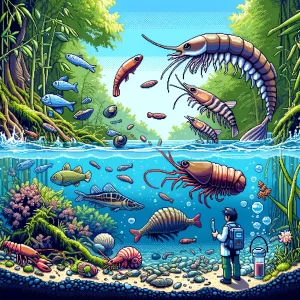
How Climate Change Impacts Wildlife Populations
Climate change is a pressing issue affecting ecosystems worldwide. One crucial aspect of this impact is how wildlife populations respond to these changes. Researchers are exploring the intricate ways climate change influences birth and death rates, subsequently affecting population growth rates. Let’s break down the key points from a recent scientific study that provides a framework for understanding these complex responses.
Understanding Non-Compensatory Effects
Non-Compensatory Effects Defined
Imagine a seesaw with birth rates on one end and death rates on the other. In an ideal situation, changes in climate would balance both sides, leading to no significant change in population growth. However, when these changes do not balance out—when one side goes up or down more significantly than the other—we have what’s called a “non-compensatory effect.” This term describes situations where climate change causes disproportionate changes in the factors that affect population growth.
Why It Matters
Understanding these non-compensatory effects is vital. If birth rates drop or death rates rise significantly without a counterbalance, populations can decline rapidly. Conversely, if birth rates rise or death rates drop significantly, populations can grow unsustainably, leading to other ecological problems.
The Framework: Mapping the Impact
Birth and Death Rates
The study presents a framework to map how climate-induced changes in “upstream” factors like temperature or precipitation affect “downstream” outcomes like birth and death rates. This mapping helps predict how populations might grow or shrink under different climate scenarios.
Examples in Nature
For instance, consider how changing temperatures affect birth and death rates in fish populations. Warmer waters might boost birth rates initially but could also increase death rates due to higher metabolic demands and lower oxygen levels. These non-compensatory effects need careful analysis to predict overall population trends accurately.
Intraspecific and Interspecific Effects
Intraspecific Effects
Changes in resource allocation can have non-compensatory effects within a species. For example, if more energy is spent on reproduction at the expense of growth or maintenance, birth rates might increase while overall health declines, leading to higher death rates.
Interspecific Effects
These effects can alter predator-prey dynamics or host-parasite relationships between species. For instance, if a warming climate increases the activity of predators more than their prey, prey populations might decline sharply, affecting the entire ecosystem.
Practical Applications
Predicting Population Changes
The framework allows researchers to predict how specific species will respond to climate changes. This prediction is crucial for conservation efforts, as it can identify species at risk of rapid decline or overpopulation.
Developing Conservation Strategies
By understanding these dynamics, conservationists can develop strategies to mitigate adverse effects. For example, managing habitats to ensure prey species can escape predators or supporting species that are crucial for ecosystem balance.
What do you think?
- How do you think human activities like deforestation or pollution might compound the effects of climate change on wildlife populations?
- Can you think of any local wildlife populations in your area that might be affected by climate change? How could this impact the local ecosystem?
Conclusion
Climate change’s impact on wildlife populations is a complex puzzle, with non-compensatory effects playing a crucial role. By mapping these effects, researchers can better predi
Transform Your Science World
Get the latest and most inspiring scientific updates with ‘This Week in Science’! Perfect for educators and science enthusiasts, our free weekly newsletter delivers groundbreaking research and stories that ignite your passion for learning and teaching. Sign up today and transform your approach to science.



